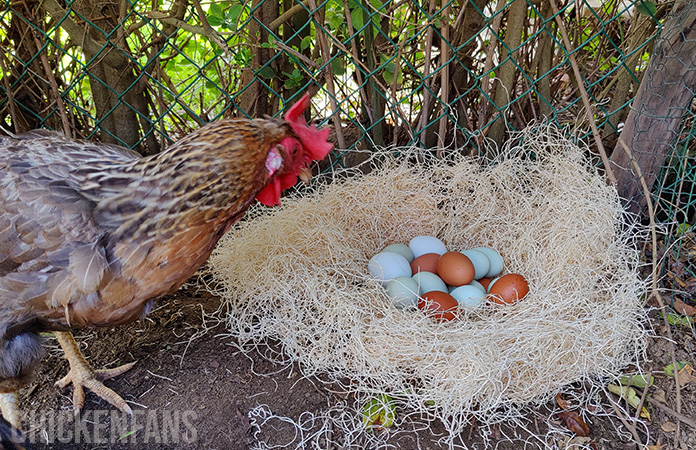How Many Eggs Does a Chicken Lay?
Chickens are remarkable egg-laying machines, providing a steady supply of nutritious eggs for human consumption. However, the number of eggs a chicken lays can vary depending on several factors, such as breed, age, and environmental conditions. In this comprehensive article, we will explore the intricacies of chicken egg production, including the factors that influence it, the average number of eggs laid per year, and strategies to maximize egg yield. We will also include a FAQ section and a summary table with key information.
Understanding Chicken Egg Production
Egg production in chickens is a complex process that involves several stages. It begins with the formation of the yolk in the hen’s ovary, followed by the addition of egg white and the shell as the egg travels through the oviduct. This process takes approximately 24 to 26 hours, meaning that a hen typically needs more than a full day to produce and lay an egg.Even the most productive laying breeds, such as White Leghorns and ISA Browns, will average about one egg every two out of three days. This means that over a week, a good layer can produce around 5 to 6 eggs. However, it’s normal for hens to occasionally skip a day or more between laying.
Factors Influencing Egg Production
Several factors can affect the number of eggs a chicken lays. Understanding these factors is crucial for maintaining optimal egg production in your flock.
1. Breed
Different chicken breeds have varying egg-laying capabilities. Some breeds, known as “layer” breeds, have been selectively bred to be high-production layers. Examples include White Leghorns, Rhode Island Reds, and Australorps. These breeds can lay up to 300 eggs per year.Other breeds, such as Orpingtons and Wyandottes, are considered “dual-purpose” breeds, meaning they are good for both egg production and meat. These breeds typically lay around 200 eggs per year.
2. Age
Hens lay the most eggs during their first year of production, which is typically between 18 and 24 months of age. As they age, their egg production gradually declines. By the time a hen reaches 2 years old, her egg production may be reduced by as much as 50%.
3. Diet
A well-balanced diet is crucial for maintaining optimal egg production. Hens need a diet that provides all the necessary nutrients, including proteins, vitamins, minerals, and other essential nutrients. A deficiency in any of these nutrients can lead to a decrease in egg production.
4. Light
Chickens require a minimum of 14 hours of light per day to maintain consistent egg production. As the days get shorter in the fall and winter, egg laying may decrease or stop altogether. To maintain egg production during these months, you can provide supplemental lighting in the coop.
5. Health
Healthy hens lay more eggs than sick or stressed hens. Factors such as parasites, diseases, and poor living conditions can all contribute to decreased egg production.
Average Egg Production per Year
The average number of eggs a chicken lays per year can vary depending on the breed and other factors. Here are some estimates for common chicken breeds:
- White Leghorns: 280-320 eggs per year
- Rhode Island Reds: 200-280 eggs per year
- Australorps: 200-280 eggs per year
- Orpingtons: 180-240 eggs per year
- Wyandottes: 180-240 eggs per year
It’s important to note that these are just estimates and that individual hens may lay more or fewer eggs depending on their specific circumstances.
Strategies for Maximizing Egg Production
If you want to maximize the number of eggs your chickens lay, consider implementing the following strategies:
1. Choose the Right Breed
Select a breed that is known for its high egg production, such as White Leghorns or ISA Browns. These breeds are bred specifically for their egg-laying abilities.
2. Provide a Balanced Diet
Feed your chickens a diet that is high in protein, calcium, and other essential nutrients. You can supplement their diet with calcium-rich foods such as crushed eggshells or oyster shells.
3. Maintain a Consistent Light Schedule
Provide your chickens with at least 14 hours of light per day, either through natural sunlight or supplemental lighting. This will help maintain consistent egg production throughout the year.
4. Keep Your Chickens Healthy
Regularly check your chickens for signs of illness or parasites, and take steps to prevent the spread of disease. Provide a clean, stress-free environment for your chickens to thrive in.
5. Collect Eggs Regularly
Collect eggs from the nesting boxes at least once a day. This will encourage your hens to continue laying eggs, as they will not be sitting on them and incubating them.
FAQ Section
1. How many eggs does a chicken lay per day?
On average, a healthy, young hen will lay an egg every 24 to 36 hours during her prime laying years, which is typically her first laying season. However, this frequency can vary depending on factors such as breed, age, season, diet, environment, and overall health.
2. What is the average number of eggs a chicken lays per year?
The average number of eggs a chicken lays per year can vary depending on the breed. White Leghorns, which are known for their high egg production, can lay up to 320 eggs per year. Other breeds, such as Rhode Island Reds and Australorps, can lay between 200 and 280 eggs per year.
3. Do all chickens lay eggs every day?
No, not all chickens lay eggs every day. Even the most productive layers will occasionally skip a day or more between laying. On average, a hen may lay an egg every two out of three days.
4. How long do chickens lay eggs?
Chickens typically lay eggs for the first 1-2 years of their life. As they age, their egg production gradually declines. By the time a hen reaches 2 years old, her egg production may be reduced by as much as 50%.
5. What factors affect a chicken’s egg production?
Several factors can affect a chicken’s egg production, including breed, age, diet, light exposure, and overall health. Choosing the right breed, providing a balanced diet, maintaining a consistent light schedule, and keeping your chickens healthy are all important strategies for maximizing egg production.
Conclusion
Chickens are remarkable egg-laying machines, providing a steady supply of nutritious eggs for human consumption. However, the number of eggs a chicken lays can vary depending on several factors, such as breed, age, and environmental conditions. By understanding these factors and implementing strategies to maximize egg production, you can ensure a consistent supply of fresh eggs from your backyard flock.For more information on chicken egg production, you can refer to the USDA’s National Agricultural Library.
Summary Table
| Breed | Eggs per Year |
|---|---|
| White Leghorns | 280-320 |
| Rhode Island Reds | 200-280 |
| Australorps | 200-280 |
| Orpingtons | 180-240 |
| Wyandottes | 180-240 |



